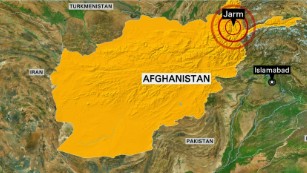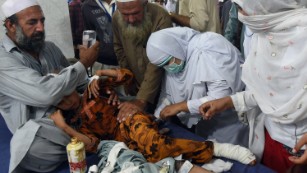Deaths, damage reported in powerful Afghanistan quake

The powerful earthquake that struck northeastern Afghanistan Monday also rattled people in Pakistan, India and Tajikistan, killing hundreds, collapsing structures and creating panic.
The panic in itself was deadly — in one northern Afghan town, 12 schoolgirls died in a stampede as they tried to evacuate their school during the quake.
The girls, between 10 and 15 years old, were crushed in their Taluqan city school’s stairwell, between the first and second floors, local police spokesman Abdul Khalil Asir said.
Early reports from Afghan, Pakistani and Indian officials put the death toll more than 200, with hundreds of others injured.
At least 200 deaths have been reported in Pakistan’s Khyber Pakhtunkhwa province and the Federally Administered Tribal Areas that border Afghanistan, according to district coordination officials. Afghan officials report at least 34 deaths in that country’s northeastern provinces. One death has been reported in Indian-administered Jammu and Kashmir.
Monday’s magnitude-7.5 earthquake was more powerful than a similar, magnitude-7.6 quake in nearby Kashmir that killed 18,000 in 2005. But unlike the quake 10 years ago, this one happened deep inside the earth, some 223 km (139 miles) below the surface.
Earthquakes at this depth typically cause less damage on the surface than shallower quakes, according to the U.S. Geological Survey.
The epicenter of the earthquake, near the Afghan city of Jarm, is a rural and sparsely populated area. Many people in this region live in mud brick buildings prone to collapsing. The mountainous region and poor infrastructure make assessing the aftermath difficult.
First responders scrambled to the affected areas, as many of the villages most violently shaken by the quake are not easily accessible. Additional reports of fatalities and damage are expected to continue trickling in.
Afghan broadcaster Tolo TV showed images of collapsed structures.
The USGS issued an orange alert on the quake. “Significant casualties are likely and the disaster is potentially widespread. Past events with this alert level have required a regional or national level response,” the USGS said.
Kabul: ‘It was really bad’
“It was really bad,” said Masoud Popalzai, CNN’s producer in Kabul. “In 30 years of my life, it was the worst I experienced myself.”
Everyone ran out into the streets. The walls of his compound shook so hard, they looked like they might fall over.
“In the bathroom everything swayed,” he said. “Things fell to the ground in the office’s kitchen.”
But he has seen no signs of damage in Kabul, even after driving a few miles around the city.
Some 60 miles southwest of Kabul, in the town of Ghazni, there were reports that the historic gate had collapsed, accompanied by photos on social media.
Islamabad shakes
In Islamabad, Pakistan, CNN correspondent Sophia Saifi was standing in the kitchen when her microwave fell. She ran out of her building as it began to shake.
Minutes later, as she stood outside, the ground was still trembling.
“We can feel tremors at sporadic intervals,” she said. But people were calm, trying to make cell phone calls, while children played in the streets around them. There was no damage Saifi could see.
In Quetta, near the border with Afghanistan, there were no reports of casualties, Saifi said, but there were “structural damages.”
Pakistan’s military has been activated without waiting for formal orders, a military spokesman said in a tweet.
Northern Pakistan has seen recent heavy rains, and there are fears the quake may have triggered landslides.
In the Hunza Valley in that region, the quake reportedly shook loose a landslide at a mountain glacier. Photos circulated on social media.
New Dehli, India, rumbles
Hundreds of miles away in CNN’s bureau in New Delhi, India, bureau chief Ravi Agrawal felt tremors.
“We could feel a fair bit of shaking,” he said. “We could see tables shaking a little bit; the TVs on the wall were shaking a little bit.”
“The last earthquake that brought shakes as bad as that was the Nepal earthquake,” Agrawal said.
India’s government expressed willingness to help out.
“I have asked for an urgent assessment and we stand ready for assistance where required, including Afghanistan & Pakistan,” Indian President Narendra Modi said in a tweet.
Quake felt in Kyrgyzstan
The earthquake was felt all the way up in Bishkek, the capital of Kyrgyzstan.
Kyrgyz political activist Edil Baisalov told CNN that the shaking was “not unusual for us but quite long tremors. As far as I know no damage in Kyrgyzstan.”














